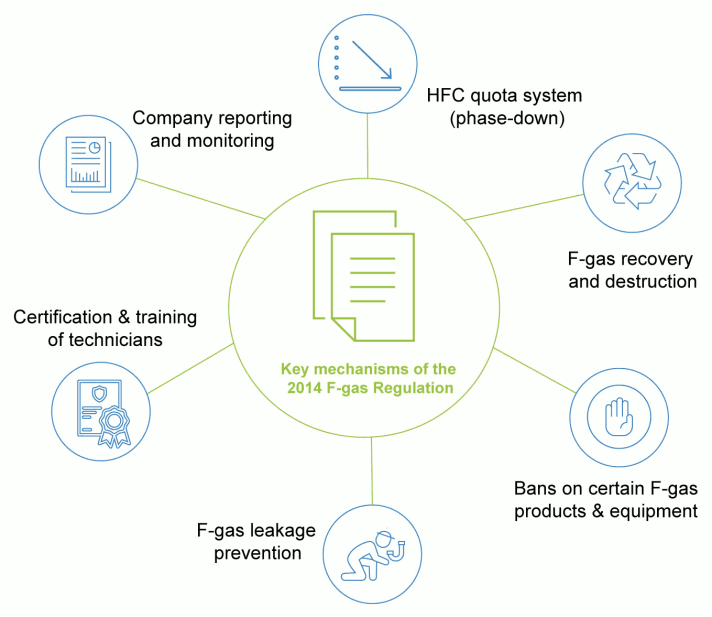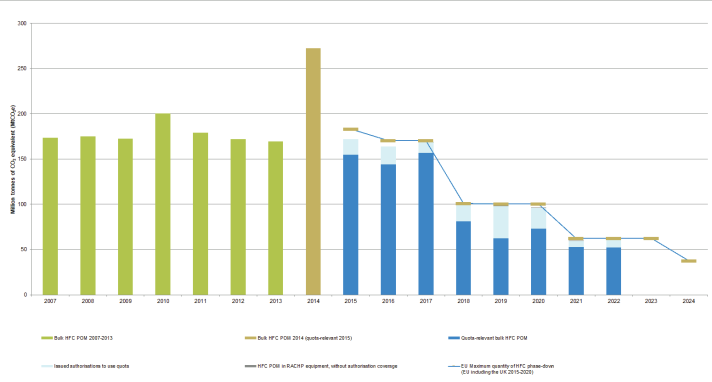What was our goal?
This law has been a true game-changer in fighting emissions from harmful fluorinated gases, setting a global example for others to follow and making it one of the EU’s landmark climate policies.
Between 2015 and 2024, the 2014 F-gas Regulation aimed to significantly cut down the use of hydrofluorocarbons (HFCs), the most common F-gases, by implementing a quota system. These gases are used in appliances such as refrigerators and air conditioners and can trap a lot of heat in the atmosphere, contributing to global warming. The system introduced by the EU set limits on how much HFCs could be sold on our market, encouraging companies to use less harmful alternatives, and improving how we handle and dispose of these gases.
In addition, some types of measures from the previous 2006 Regulation, which proved to be effective like the bans on certain equipment using F-gases and measures to prevent emissions from equipment, were further developed.

Key mechanisms of the 2014 F-gas Regulation

Diagram displaying the six key mechanisms of the 2014 F-gas Regulation, with a central descriptor surrounded by circles detailing company reporting, HFC phase-down, F-gas recovery, equipment bans, leakage prevention, and technician certification, on a white background.
Key Strategies and their impact
- 1. Quota system and phase-down schedule
Since 2015, an EU cap on HFCs has been reducing their market presence to lower emissions of F-gases. The 2014 Regulation introduced a declining quota for HFCs, pushing towards using greener alternatives and promoting recycling. Higher HFC prices encouraged the switch to climate-friendly options, leading to cost savings, better energy efficiency, and increased recycling.
- 2. Bans on specific products and equipment
The Regulation prohibited the use of certain products and equipment that contain F-gases with a high global warming potential, particularly in refrigeration and air-conditioning equipment where this was comparatively easy and economical (e.g. in fridges at home or supermarkets).
- 3. Leakage prevention
It sets rules to prevent and fix leaks from equipment using these gases, reducing accidental emissions into the atmosphere. Operators of equipment that contains F-gases in quantities of 5 tonnes CO2 eq or more and not contained in foams have been obliged to ensure regular leak checks.
- 4. Certification and training
The 2014 F-gas Regulation ensured that individuals working with these gases were properly trained. This included certifying technical personnel and companies involved in installing, servicing, and maintaining F-gases, ensuring that the equipment was handled safely and efficiently.
- 5. Recovery and Disposal
It emphasized the importance of recovering and safely destroying these gases. Proper handling ensures that these potent greenhouse gases are neutralised, reducing their harmful effects on our climate.
- 6. Reporting and Monitoring
Companies must report annually on information such as the amount of F-gases they placed on the EU market as bulk or pre-charged in equipment, as well as on activities such as recovery, recycling, and destruction. This information enabled better monitoring and enforcement efforts.
Results
The 2014 F-gas Regulation has been a cornerstone of the EU's climate policy. Thanks to its implementation, there has been a consistent and significant reduction in F-gas emissions across the EU from 2015 to 2024. This regulation went beyond merely mitigating climate impact; it catalysed advancements in innovation and green technology, especially within the refrigeration and air-conditioning sectors.
1. Reduction of HFCs on the EU-market
The EU has consistently achieved the yearly goals outlined in the 2014 F-gas Regulation. From 2015 to 2023, the amount of HFCs placed on the EU market dropped by 69%. The quota system and restrictions combination proved effective, particularly for HFC refrigeration and air conditioning equipment.

Further information: HFCs placed on the EU market and the targets set out in the 2014 Regulation
In total, from 2015 to 2022, the EU’s HFC supply fell by 52% in CO2 equivalent- emissions (37% in metric tonnes). These numbers imply that the average global warming potential of HFCs used in the EU also fell significantly. This proves that market players started to focus more on less climate-active HFCs (as seen in the graph below).

2. Big cut in F-gas emissions
Between 2014 and 2022, EU legislation led to a 25% drop in emissions from F-gases, cutting down nearly 100 million tonnes of CO2 equivalent. The biggest improvements were seen in the cooling industries, like refrigeration and air conditioning.
Why this matters
During the 1990s, HFC quickly became popular as a replacement for other harmful gases that damaged the ozone layer, particularly in refrigeration and air conditioning, as well as products such as foams and aerosols. The emissions of F-gases in the EU doubled from 1990 to 2014—in contrast to emissions of all other greenhouse gases, which were reduced.
Perfluorocarbons (PFCs) and Sulfur Hexafluoride (SF6) are other F-gases known for their strong ability to trap heat in the atmosphere. Efforts to reduce their use saw progress until around 2010 when industries and manufacturers started to understand the impact of these gases and began adopting better practices and technologies to minimise their release. However, after 2011, the reduction in emissions from these gases levelled off.
Currently, emissions from F-gases make up about 2.5% of all greenhouse gas emissions in the European Union. This is double what it was between 1990 and 2014, which stands out since emissions from other greenhouse gases have decreased.

3. Leading in eco-friendly cooling tech
The EU has taken big steps toward using more climate-friendly cooling methods, setting an example for the rest of the world. By focusing on reducing harmful F-gases, the EU has sparked a wave of innovation and a shift toward greener alternatives.
Why this matters
- Businesses, especially supermarkets, are now using carbon dioxide (CO2) instead of harmful gases for refrigeration, with CO2 being used 28 times more in 2023 than it was in 2013. This switch is important because CO2 is much less harmful to the climate than traditional F-gas refrigerants.
- The EU made this happen by increasing the cost of harmful F-gases and limiting their availability. This encouraged businesses to look for better, climate-friendly options.
- As a result, the prices for greener alternatives remained stable, making them more appealing compared to the more costly F-gases. Businesses that chose these greener options were not only doing the environment a favour but also cutting costs.
- This approach led to significant innovation in the sector. More and more businesses have started using technologies that don't rely on harmful HFCs, showing a clear move towards sustainability.
The benefits
- The use of CO2 as a natural refrigerant in food retail skyrocketed by 2800% from 2013 to 2023, demonstrating a massive shift toward more sustainable refrigeration practices.
- Despite a steady import of products and equipment that traditionally used HFCs to the EU, the overall impact of these gases on global warming decreased by 33% from 2016 to 2019. This indicates a significant move away from using the most damaging HFCs to options with lower warming effects on our planet.
4. Increase of reclamation of F-gases in the EU
From 2014 to 2022, the amount of these gases being recycled — a process also known as "reclamation" —more than doubled. This surge in recycling is largely due to the rules that made these gases more economically valuable, encouraging companies to recycle them instead of letting them go to waste. While recycled gases are just as good as new ones, they don't count towards the quota set by the legislation on how much F-gases can be placed on the EU market.
What does reclamation mean?
Reclamation is a technical term that refers to cleaning used F-gases up so they're as good as new. It's like taking a used bottle, washing it, and filling it up again so it can be reused. In 2019, about 8% of all the gases produced were recycled in this way. Most of these were the common cooling gases, HFCs, with smaller amounts of another gas, SF6, also being recycled because of its impact on climate change.
HFCs represent most reclaimed F-gases in metric tonnes (accounting for 97% of them), with SF6 contributing approximately 20% in tonnes of CO₂ equivalent of reclaimed gas.
Where does this happen?
Recycling these gases requires special facilities. However, not all EU countries have them, and cross-border shipments are challenging to organise. For example, Poland has been particularly successful at recycling these gases, increasing their recycled amount from 30% to 44% between 2019 and 2020.
5. Less leakage and better end-of-life treatment of F-gases in equipment
Many devices and products in the EU use F-gases, which can harm the climate if they escape into the atmosphere. To tackle this, it's crucial to prevent these gases from leaking and to manage them responsibly when equipment reaches the end of its life.
Why this matters
Surveys from various European countries highlight the importance of regularly checking and servicing equipment, especially in supermarkets and other commercial settings. Thanks to these efforts, the rate at which F-gases leaked from cooling systems dropped significantly from 12.6% in 2016 to just 3.0% in 2020. This trend was noticed not just in Poland but also in Germany and Slovakia, showing widespread improvement. Such reductions result in both savings on adding new (expensive) gas and better equipment energy efficiency.
The benefits
Reducing leaks has two major advantages:
- Cost savings: Fewer gas leaks mean we don't have to replace lost gas as often, which is economical because this gas can be expensive.
- Energy efficiency: Equipment runs more efficiently when properly sealed and maintained, thereby saving energy.
Recovering and recycling gases
There's also good news about recovering these gases when equipment is being fixed or thrown away. In France, for example, reports show that much of the gas was successfully collected and recycled. This recovery process ensures that gases can be reused rather than released into the environment, further reducing waste and emissions.
6. The EU as frontrunner in reducing F-gases
The EU has set a standard with its 2014 F-gas Regulation, leading the way in reducing emissions from F-gases. This initiative showcases the EU's proactive regulatory approach, commitment to international goals, promotion of alternatives, investment in research and innovation, and collaboration with various stakeholders.
EU's leadership role: The 2014 Regulation was a game-changer. It proved that significant action against harmful HFCs isn't just necessary; it's entirely possible. By taking early and decisive steps, the EU has inspired countries worldwide to consider similar measures.
Global influence: This regulation wasn't just about making changes within the EU. It was crucial in shaping the Kigali Amendment under the Montreal Protocol. This global agreement started in 2019 with the intention of cutting down the production and use of HFCs worldwide. Before this, there wasn't a united global effort to tackle the issue of HFCs, which are known for their strong greenhouse effect.
7. EU far below global target
In 2022, the EU's HFC consumption was 55% below the limit set under the Kigali Amendment to the Montreal Protocol.
For the EU and other developed economies, the international phase-down schedule begins at 90% of the baseline and is set to decrease to 15% by 2036. So far, the EU is on an upbeat track to fulfil its Montreal Protocol obligations.
Looking ahead
The success of the 2014 regulation shows what can be achieved with determined and collective action. By continuing to lead with strong policies and cooperation, the EU is proving that it's possible to make significant changes that benefit the planet and our economies. This progress isn't just about meeting goals; it's about setting a global example for transitioning to safer, greener technologies and practices.
Additional Information:
Internationally, HFC consumption is regulated through the Kigali Amendment to the Montreal Protocol. Enacted in 2019, this amendment commits developed and developing countries to reduce HFC consumption, following progressively declining targets.
